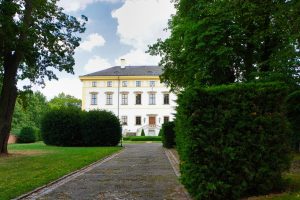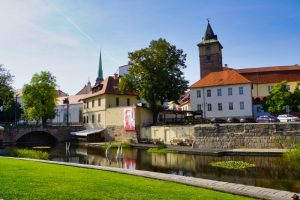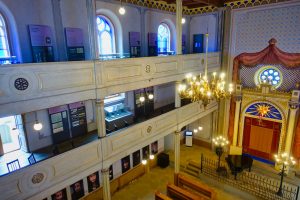Around Pilsen there are numerous former monasteries, which today invite you to visit them. Each monastery has something special and many facilities are architecturally unique. Plasy Monastery is one of the largest monasteries in the region.
Plasy Monastery is located in the Pilsen-North district and can be reached in a good 30 minutes by car. There is also a possibility to go there by bus (duration about 50 minutes). The outdoor area is open to the public. Those who wish to go inside the buildings can take part in a guided tour for which a fee is charged. Some area are used as exhibition areas.

History of the monastery
The Cistercian monastery is founded in 1146 by Prince Vladislav II . The Cistercians, a monastic order founded in the 11th century in Cîteaux, France, were known for their strict rule and their contribution to the spread of Christianity and culture in Europe. They played a crucial role in colonizing and cultivating the regions in which they operated. In 1204 the first stone building, the Romanesque monastery basilica, was completed. In the Middle Ages, due to its good economic position, the monastery developed into one of the most important and also quite large convents in the Kingdom of Bohemia.

The monastery burned down during the Hussite wars. The property was distributed to several nobles, who did not really feel responsible for the site. The complex fell more and more into disrepair. It was only from 1621 that the monastery gradually got back its property and came back to life.

Over the years, the monastery was often rebuilt. These works were particularly extensive in the period 1685-1740, when master builders such as Jean Baptiste Mathey, Jan Blažej Santini-Aichel and Kilian Ignaz Dientzenhofer were involved in the works. A granary with a tower, the prelature and the convent were built. The monastery church was also remodeled in the Baroque style.
In the course of the Josephine reforms at the end of the 18th century, introduced under Emperor Joseph II of Austria, monasticism in the Habsburg lands experienced a sharp decline. Many monasteries, including Plasy, were secularized. That is, they lost their religious character and were expropriated.

From 1826 to 1945 the monastery belonged to the Princely House of Metternich. A cultural center was established. In 1945/46 the state took over the estate. During this time valuable historical objects of the family were destroyed, damaged, sold or stolen.
Under socialism, the state took over the building. For a while the buildings were still used, then they visibly decayed.

Since 1993, the building complex has been restored. Today, Plasy Monastery is a national cultural heritage and a popular tourist destination. It houses various exhibitions dealing with the history of the monastery, the Cistercians and Czech history in general.
Plasy Monastery: Monastery Church
The monastery church of Plasy, also called the Convent Church of the Assumption of the Virgin Mary, is an important part of the monastery complex and represents its spiritual and religious center.

The church was originally built in Romanesque style when the monastery was founded in the 12th century. However, over time the church was rebuilt and expanded several times. The monastery church received its current Baroque appearance in the 18th century, especially through the work of Jean Baptiste Mathey and later Kilian Ignaz Dientzenhofer. Santini-Aichel, known for his unique style of “Baroque Gothic,” also remodeled the church in Plasy in the 18th century. His work combines Baroque forms and structures with Gothic motifs, resulting in impressive architectural works. His approach to interior design, often using complex geometric patterns and shapes, is also evident in this church.


The church houses numerous works of art, including paintings, sculptures and altarpieces. Some of the most notable works of art are the frescoes on the ceiling depicting scenes from the life of the Virgin Mary.

The chapter house
We enter a large very high room. Here the monks once gathered on particularly festive occasions and in the morning to read aloud from the Rule of Benedict. They sat on benches at the edge of the room, because that was where the acoustics were best.

A high dome rises above me and while I am still looking at the picture at a height of over 27 meters, our guide begins with his explanations. He must talk in a very strange way, because there is an echo in the room. This lasts a good 10 seconds and so he always says only 2-3 words, waits and speaks after the reverberation has faded. I wonder how the monks could talk or discuss with each other here. It must have been a hopeless babble of voices.
Library Room
Monasteries and the subject of books belong together. For many years, monks were the only people who could read and write. They collected their knowledge in often excellently equipped libraries.

In Plasy monastery there was, of course, also a collection of books. Somewhere in the middle of the 18th century the monks are said to have stored more than 12000 books there. Today there are only some original bookcases. Unfortunately, in the middle of the 19th century, the Metternich family remodeled the room so that theater and music events could be held there. After the dissolution of the monastery, parts of the books were taken to other monasteries. Another part of the books fell victim to a devastating fire in 1894.
It is not allowed to enter the hall, but from the door there is a good view into the room. Between the windows hang some pictures showing the abbots of the monastery. I especially like the large globe in the middle of the room and the beautiful ceiling design.
Santini’s famous spiral staircase
As we walk down a corridor from the convent to the hospital wing, we are pointed to a staircase. This is where Santini created his famous spiral staircase.
The spiral staircase in the Convent of Plasy is an outstanding example of Santini’s ability to find innovative and creative solutions to architectural challenges, creating works of art of lasting beauty and significance.

The staircase is a cantilever structure without a central column, which was a remarkable technical achievement for the time of its creation. This design gives the staircase a sense of lightness and elegance. It spirals upward, creating a play of light and shadow caused by the surrounding windows and the structure of the staircase itself.
This oval-shaped masterpiece is not only a staircase, but also a ventilation shaft. When the windows are opened on the upper floor, the warm air flows in and pushes the cold air down. I read that the staircase is one of 4 self-supporting staircases in the convent.

I just love the view of the stairwell!
Plasy Monastery and the Plasser Powder
The Cistercians are known for their knowledge in the field of nursing. Plasy Monastery also had a hospital wing, but it was mainly used to treat sick monks. The hospital church was connected with the adjacent rooms only by small windows. The priest opened these exclusively during the service in order to avoid infection as much as possible.

I particularly liked the pharmacy. The monastery pharmacy became famous for the Plasser powder that was produced here. The healing springs and minerals in the surroundings of Plasy were already known in the Middle Ages. The monks of the Cistercian monastery in Plasy used this knowledge and researched the healing properties of the water and minerals. In this context they discovered the “Plasy powder”.

It is a white mineral powder consisting, among other things, of alum slate, which is supposed to help against stomach, intestinal and bilious complaints, but also heal skin diseases. The powder is still produced according to the original recipe of Lukas Martin Gottlieb.
I almost overlooked it. There is also a baroque toilet here. From the “thunder beam” everything falls into an artificial channel, which has its water intake from the river Strela.

The water system in Plasy Monastery
Plasy Monastery is famous for its sophisticated water system. This system, developed and optimized over the centuries, is an impressive example of the technical skills and innovative spirit of the monks and the engineers and architects involved. Jean Baptiste Mathey carried out the fundamental work on the Plasy water system in the 17th century. Santini-Aichel was responsible for further development and beautification in the 18th century.
The building was erected in the floodplain. Standing by a water basin, I learn that the foundation of the convent stands on hewn and burned oak logs. Altogether there are supposed to be more than 5000 logs, which were let into the ground for this purpose. The logs must always stand in the water so that they do not rot and collapse.

To meet the water needs of the monastery and to keep the oak pillars constantly wet, an extensive system of canals, moats and ponds was built. This network served not only to stabilize the buildings, but also other purposes such as fish farming, mill operations and as a decorative element in the monastery’s gardens. The monks and architects had to rely on observation, experience and simple tools to create this complex system.
Today, the water system of Plasy Monastery is not only a technical monument, but also an important ecological reservoir. The ponds and canals provide habitats for a variety of plants and animals.
Address:
Plzeňská 2,
331 01 Plasy
The visit to Plasy Monastery was a program item of a press trip with Pilsen Region and Pilsen-Tourism.


























Leave a Reply